Physical Address
304 North Cardinal St.
Dorchester Center, MA 02124
The major salivary glands associated with the oral cavity, pancreas, and liver are considered to be the extramural glands of the digestive system. Each of these glands has numerous functions aiding the digestive process; their secretory products are delivered to the lumen of the alimentary tract by a system of ducts.
There are three pairs of major salivary glands: parotid, sublingual, and submandibular.
The paired parotid, sublingual, and submandibular glands, constituting the major salivary glands, are branched ( compound ) tubuloacinar glands whose dense, irregular, collagenous connective tissue capsule provides connective tissue septa that subdivide the glands into lobes and lobules. The vascular and neural components of the glands reach the secretory units via their connective tissue elements. Individual acini are also invested by thin connective tissue elements. Each of the major salivary glands has a secretory and duct portion ( Fig. 18.1 ), where the secretory portion manufactures and releases saliva, known as primary saliva , into the system of ducts whose cells are impermeable to water. Cells of the striated ducts use active and passive transports to remove sodium and chloride ions from and add bicarbonate and potassium ions to the primary saliva. In effect, the isotonic primary saliva loses electrolytes, thereby making it hypotonic. This more dilute saliva is known as secondary saliva and is delivered into the oral cavity. The flow rate of saliva is in an indirect relationship to its tonicity; the faster the saliva flows along the striated duct, the less time the ductal cells have to alter salivary composition, and the closer the tonicity of the secondary saliva is to that of the primary saliva. The only exception to this is the concentration of bicarbonate ion, whose secretion is stimulated in concert with stimulation of primary saliva secretion.
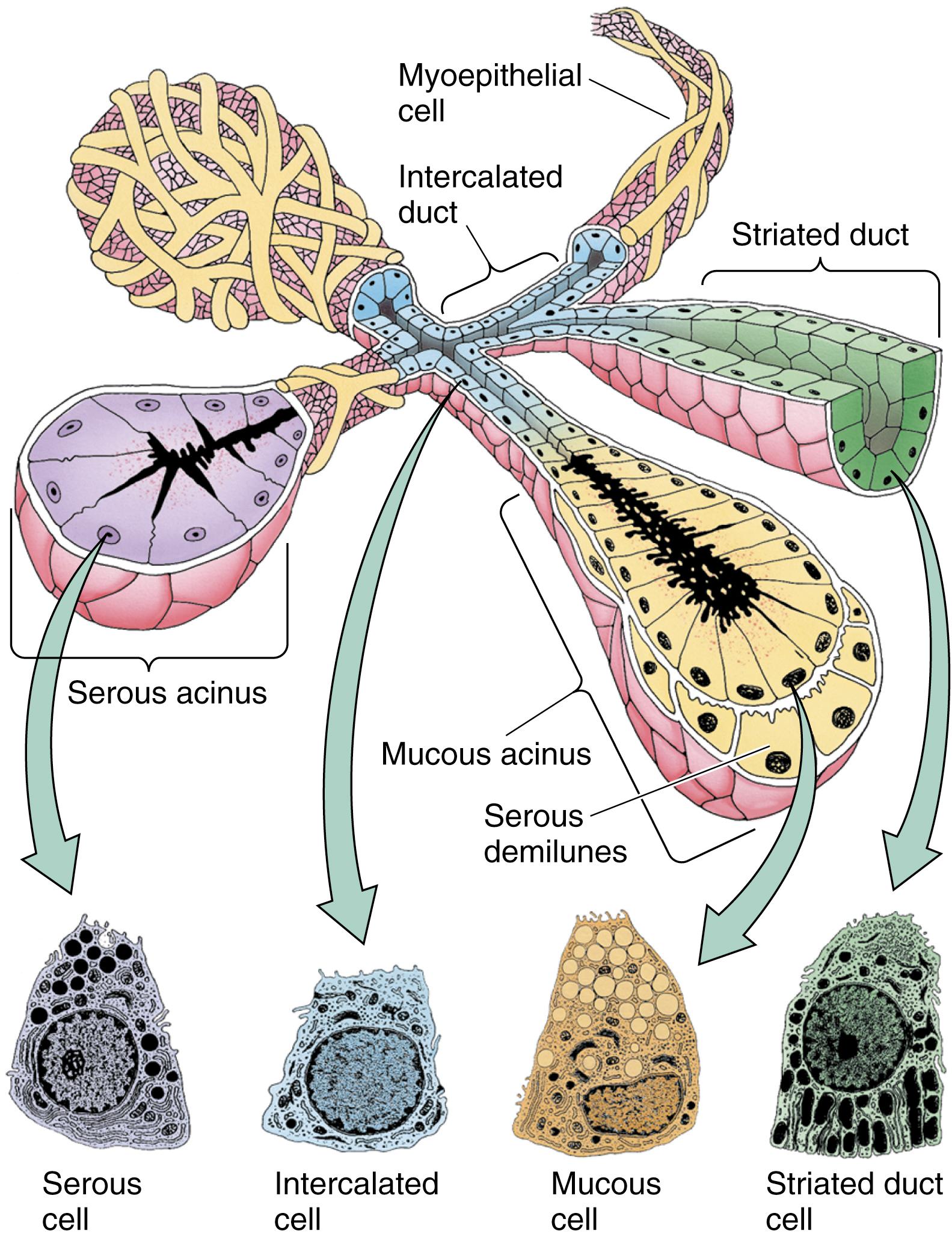
The secretory portion of salivary glands is composed of serous and/or mucous secretory cells arranged in acini or tubules that are couched by myoepithelial cells.
The secretory portion , arranged in tubules and acini, is composed of serous cells, mucous cells, and myoepithelial cells.
Serous cells ( Fig. 18.2 ) resemble truncated pyramids with a single, round, basally located nucleus, a well-developed rough endoplasmic reticulum (RER) and Golgi complex, and numerous basal mitochondria. These cells also possess an abundance of apically situated secretory granules rich in salivary amylase ( ptyalin ), an enzyme that initiates the digestion of complex carbohydrates into sugars, which they secrete along with secretory component (of the secretory immunoglobulin A [IgA] molecule), lactoferrin , lysozyme , and thiocyanate (the last three control the microbial levels of the oral cavity). The lateral plasmalemma, basal to the tight junctions, forms many processes that interdigitate and form tight junctions with those of neighboring cells.
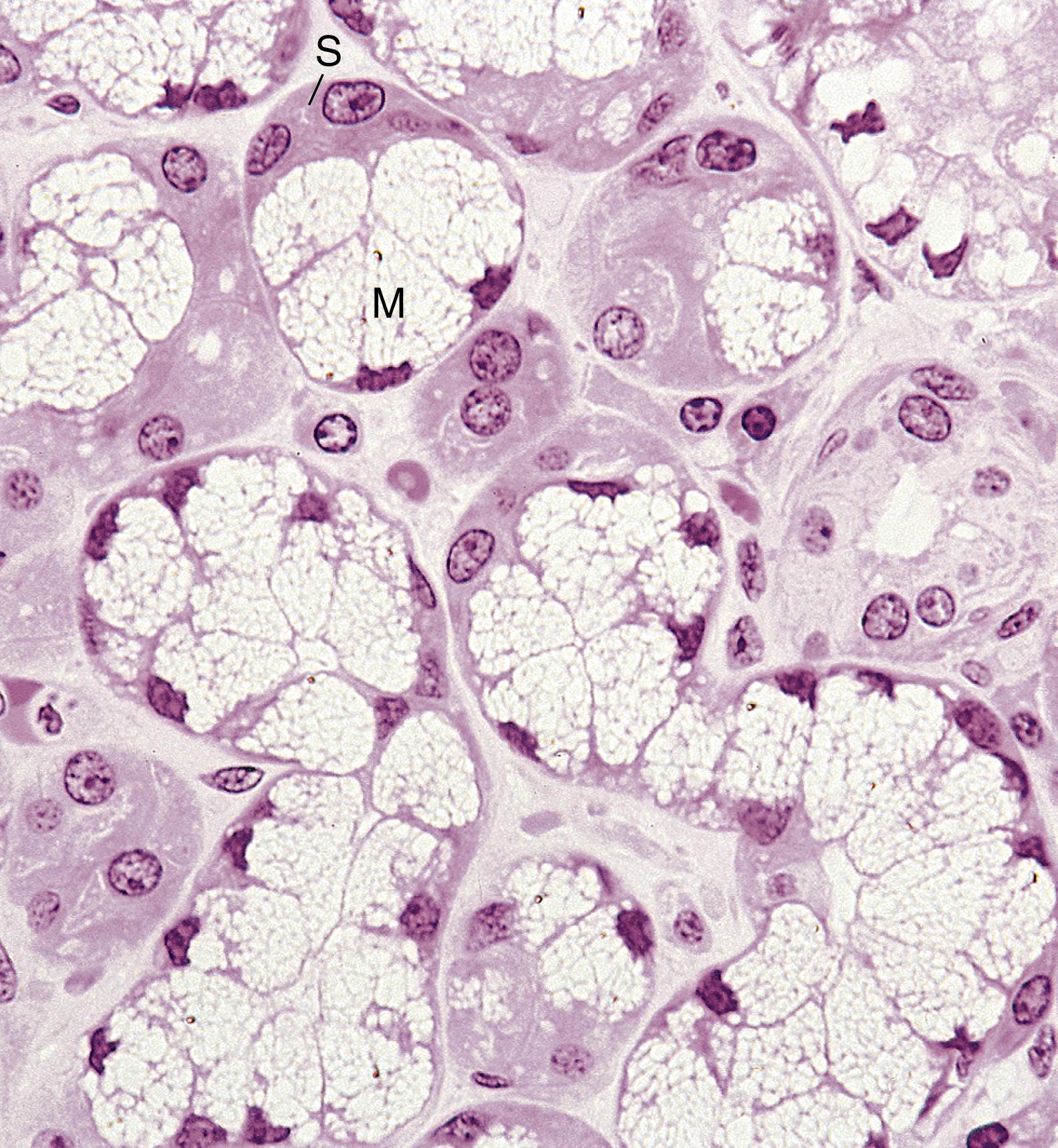
The basal aspect of the serous cells possesses IgA dimer receptor molecules that bind IgA dimers manufactured by plasma cells located in the connective tissue. The bound IgA dimer–IgA dimer receptor molecule complex becomes internalized into the serous cell and is transferred into early endosomes, where a portion of the receptor molecule is cleaved. The remainder of the receptor molecule, known as the secretory component , remains attached to the IgA dimer, which becomes known as secretory IgA (sIgA) . The sIgA is released into the saliva, where the secretory component protects it from enzymatic digestion while the immunoglobulin is still capable of combating antigens.
Mucous cells are similar in shape to the serous cells. Their nuclei are also basally located but are flattened instead of being round (see Fig. 18.2 ). The organelle population of these cells differs from that of the serous cells in that mucous secretory cells have fewer mitochondria, a less extensive RER, and a considerably greater Golgi apparatus, indicative of the greater carbohydrate component of their secretory product ( Fig. 18.3 ). The apical region of the cytoplasm is occupied by abundant secretory granules housing mucinogen , which, when released into the ducts of the gland, becomes hydrated and is known as mucin , a slippery, viscous substance. When mucin contacts and is intermixed with substances present in the oral cavity, it becomes known as mucus . The intercellular canaliculi and processes of the basal cell membranes are much less extensive than those of serous cells.
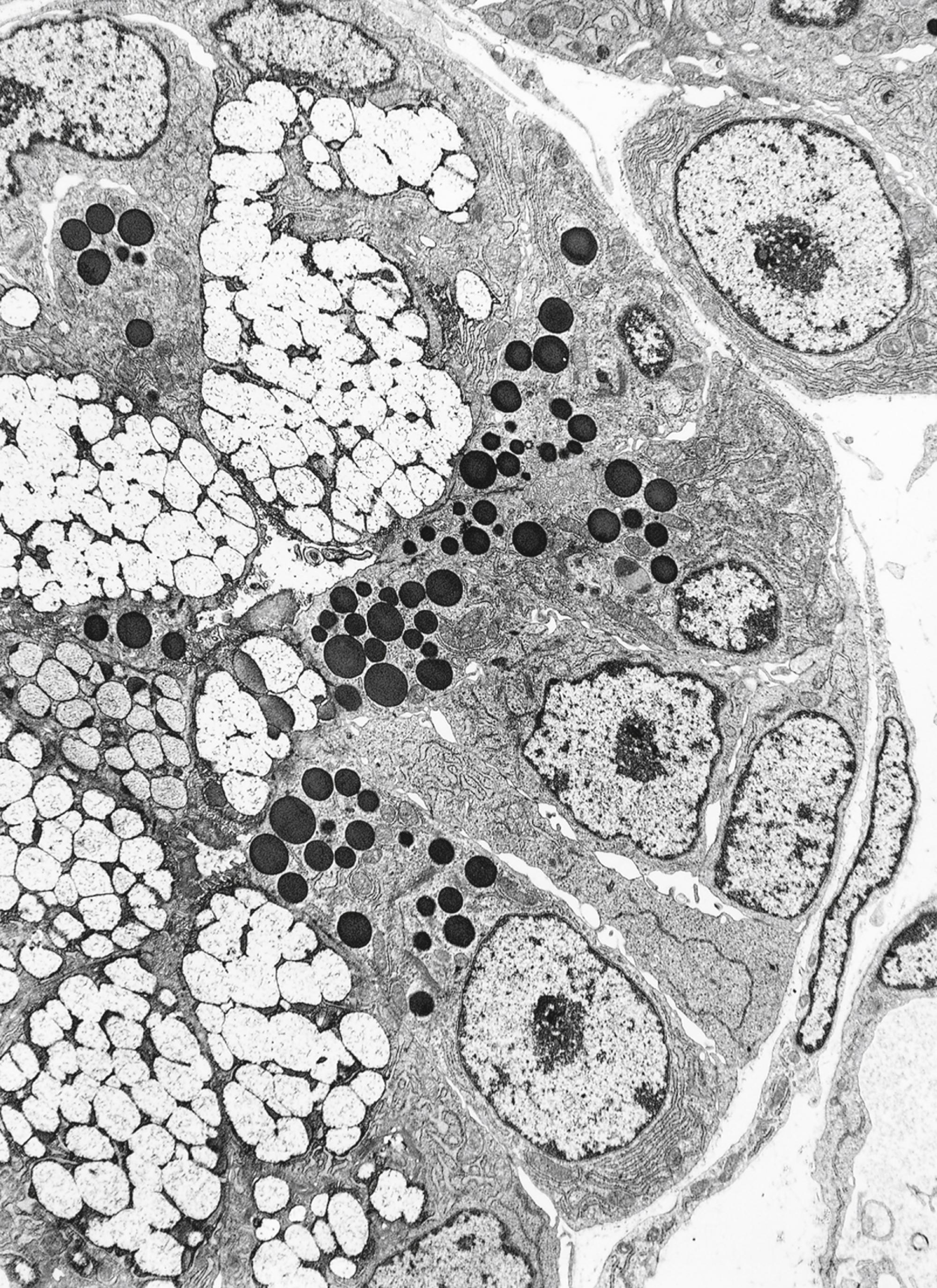
Myoepithelial cells ( basket cells ) share the basal laminae of the acinar cells. They have a cell body and several long processes that envelop the secretory acinus and intercalated ducts (see Fig. 18.1 ). The cell body houses a small complement of organelles in addition to the nucleus and makes hemidesmosomal attachments with the basal lamina. The cytoplasmic processes, which form desmosomal contacts with the acinar and duct cells, are rich in actin and myosin; in electron micrographs, these processes resemble smooth muscle cells. As the processes of myoepithelial cells contract, they compress the acinus, facilitating release of the secretory product into the duct of the gland.
The ducts of major salivary glands are highly branched and range from very small intercalated ducts to very large principal (terminal) ducts.
The ducts of major salivary glands are highly branched structures. The smallest branches of the system of ducts are the intercalated ducts , to which the secretory acini (and tubules) are attached. These small ducts are composed of a single layer of low cuboidal cells and possess some myoepithelial cells. Several intercalated ducts merge to form striated ducts , composed of a single layer of cuboidal to low columnar cells (see Fig. 18.1 ). Accentuated infoldings of the basolateral cell membranes subdivide the basal aspect of the cytoplasm into longitudinal compartments that are occupied by elongated mitochondria.
Striated ducts join together, forming intralobular ducts of increasing caliber, which are surrounded by more abundant connective tissue elements. Ducts arising from lobules unite to form interlobular ducts , which, in turn, form intralobar and interlobar ducts . The terminal ( principal ) duct of the gland delivers saliva into the oral cavity.
The acinus, intercalated duct, and striated duct together, according to some authors, constitute the salivon , the functional unit of a salivary gland.
Secretory cells of acini produce primary saliva that is modified by striated ducts to form secondary saliva.
The major salivary glands produce approximately 700 to 1100 mL of saliva per day. Minor salivary glands are located in the mucosa and submucosa of the oral cavity, but they contribute only 3 to 5 mL to the total daily salivary output. In order to be able to provide such a large salivary output, the major salivary glands have an extraordinarily rich vascular supply. In fact, it has been estimated that the basal rate of blood flow to salivary glands is 20 times greater than the flow of blood to skeletal muscle. During maximal secretion, the blood flow is correspondingly increased.
Saliva has numerous functions, including lubricating and cleansing of the oral cavity, antibacterial activity, participating in taste sensation by dissolving food material, initial digestion via the action of salivary amylase (ptyalin) and salivary lipase, aiding swallowing by moistening the food and permitting the formation of bolus, and participating in the clotting process and wound healing because of the clotting factors and epidermal growth factor present in saliva.
Acinar cells and duct cells also synthesize the secretory component required to transfer IgA from the connective tissue into the lumen of the secretory acinus or duct (see section on ducts). Secretory IgA complexes with antigens in the saliva, mitigating their deleterious effects. Saliva also contains lactoferrin, lysozyme, and thiocyanate ions. Lactoferrin binds iron, an element essential for bacterial metabolism; lysozyme breaks down bacterial capsules, permitting the entry of thiocyanate ions , a bactericidal agent, into the bacteria.
The cells of the salivary gland striated ducts secrete the enzyme kallikrein into the connective tissue. Kallikrein enters the bloodstream, where it converts kininogens, a family of plasma proteins, into bradykinin , a vasodilator that dilates blood vessels and enhances blood flow to the region.
The major salivary glands do not secrete continuously. Secretory activity is stimulated via parasympathetic and sympathetic innervation . Innervation may be intraepithelial (i.e., formation of a synaptic contact between the end-foot and acinar cell) or subepithelial. In subepithelial innervation, the end-feet of axons do not make synaptic contact with the acinar cells. Instead, they release their acetylcholine in the vicinity of the secretory cell at a distance of approximately 100 to 200 nm from its basal plasmalemma. The cell, thus activated, stimulates neighboring cells via gap junctions to release their serous secretory product into the lumen of the acinus.
Parasympathetic innervation is the major initiator of salivation and is responsible for the formation of serous saliva. Acetylcholine, released by the postganglionic parasympathetic nerve fibers, binds to muscarinic cholinergic receptors, with consequent release of inositol triphosphate, prompting the liberation of calcium ions, a second messenger, into the cytosol, which facilitates the secretion of serous saliva from the acinar cells.
Initially, sympathetic innervation reduces blood flow to the salivons, but that reduction is reversed in short order. Norepinephrine, released by the postganglionic sympathetic fibers, binds to β-adrenergic receptors, resulting in the formation of cyclic adenosine monophosphate ( cAMP, cyclic AMP ). This secondary messenger activates a cascade of kinases that result in the secretion of the mucous and enzymatic components of saliva by the acinar cells. The mucous element is responsible for the adhesion of food particles to one another in the bolus, as well as for the creation of a slippery surface, facilitating swallowing.
Salivary output is enhanced by the taste and smell of food, as well as by the process of chewing. Inhibitors of salivation include fatigue, fear, and dehydration; moreover, salivary flow is greatly reduced while the individual is asleep.
Although physically the largest of the salivary glands, the two parotid glands produce only about 30% of the total salivary output; the saliva that they produce is serous.
The largest of the salivary glands, the two parotid glands , each weigh about 20 to 30 g but produce only approximately 30% of the total salivary output. Although the parotid gland is said to produce a purely serous secretion ( Figs. 18.4 and 18.5 ), the secretory product does have a small amount of mucous component. Electron micrographs of the apical regions of serous cells display numerous secretory granules filled with an electron-dense product that has an even more electron-dense core of unknown composition.
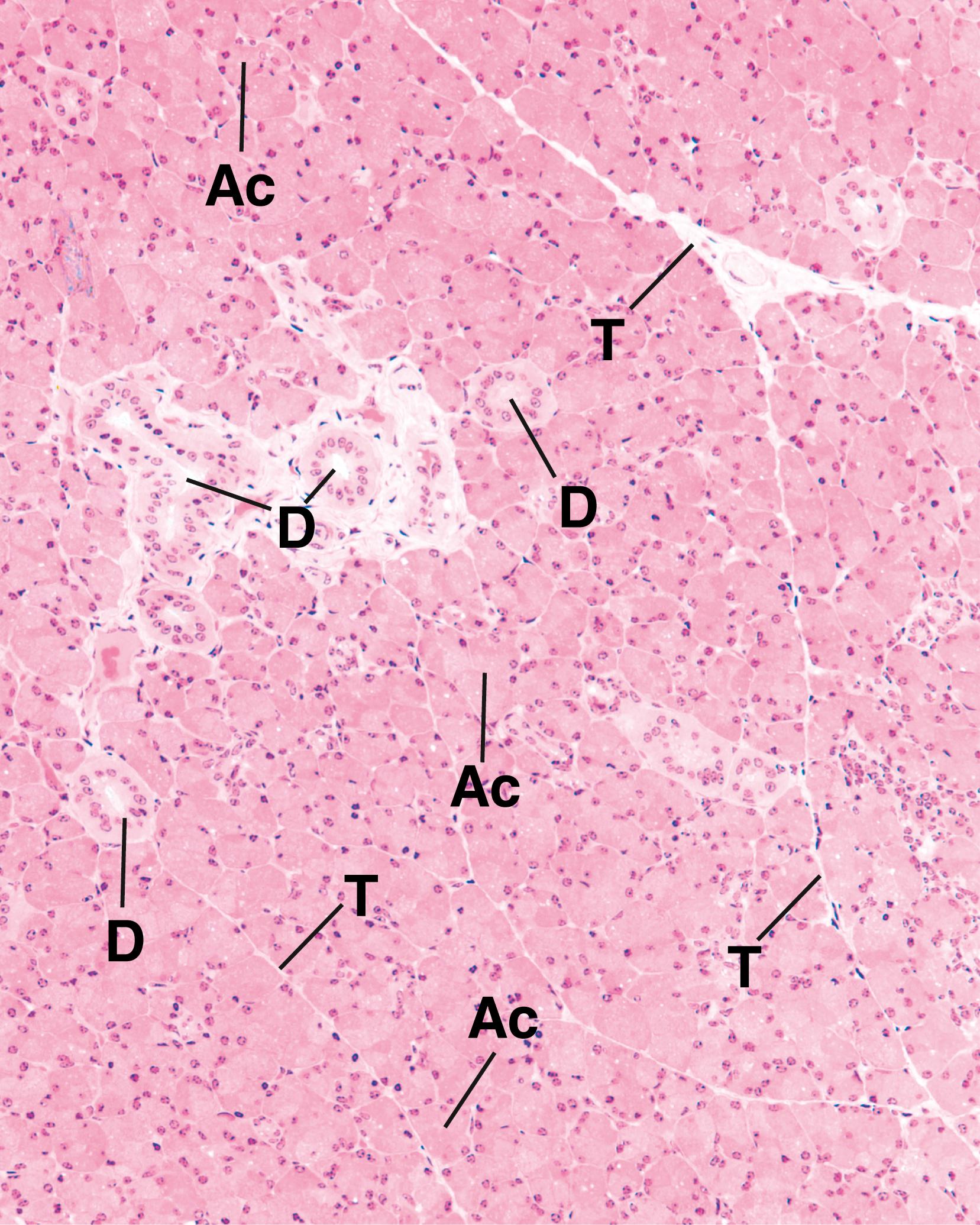
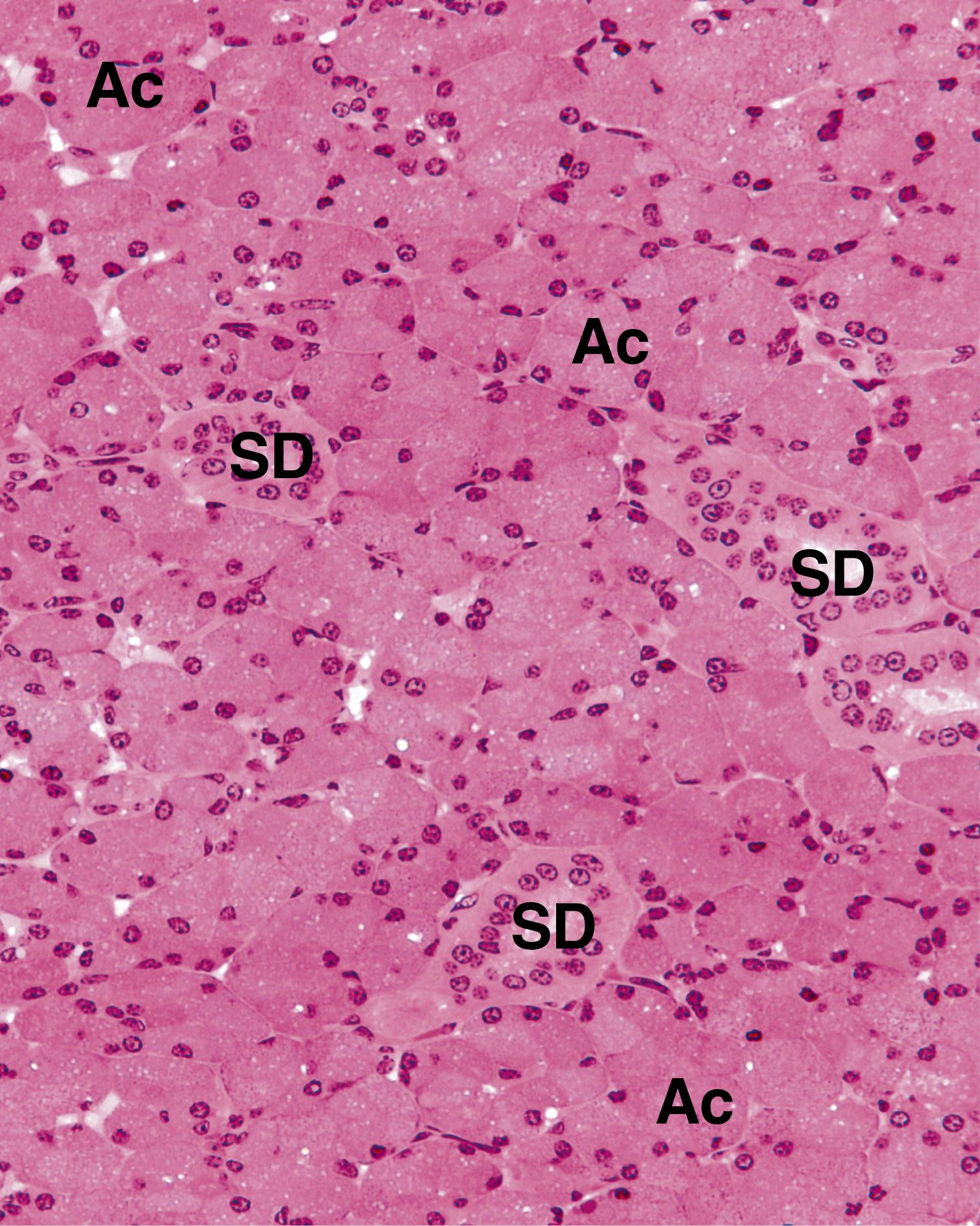
The saliva produced by the parotid gland has high levels of the enzyme salivary amylase ( ptyalin ), responsible for digestion of most of the starch in food, and secretory IgA, which inactivates antigens located in the oral cavity.
The connective tissue capsule of the parotid gland is well developed and forms numerous septa, which subdivide the gland into lobes and lobules. By the fifth decade of life, the gland becomes invaded by adipose tissue, which spreads from the connective tissue into the glandular parenchyma.
The paired sublingual glands are very small, are composed mostly of mucous acini with serous demilunes, and produce mixed saliva.
The smallest of the three pairs of major salivary glands, the sublingual glands , is almond shaped and each weighs only 2 to 3 g, producing only about 5% of the total salivary output. Each gland is composed of mucous tubular secretory units, many of which are capped by a small cluster of serous cells, known as serous demilunes ( Figs. 18.2, 18.6, and 18.7 ). Although routine light microscopy demonstrates the presence of serous demilunes, if the tissue is flash frozen, serous demilunes are absent, indicating that they may be fixation artifacts and are merely small clusters of serous cells that deliver their secretion into a lumen in common with the mucous tubular secretory units. Under normal fixation at room temperature, the mucinogen of the mucous cells become swollen, and they enlarge the cells containing them to such an extent that they squeeze most of the serous cells away from the lumen of the acinus; thus, the serous cells form a cap between the swollen mucous cells and the basement membrane. If the tissue is flash frozen, the mucinogen does not swell and the serous cells remain in their normal position, adjacent to the mucous cells. These serous cells have been shown to secrete lysozyme. The sublingual gland produces a mixed, but mostly mucous, saliva. The intercellular canaliculi are well developed between the mucous cells of the secretory units. Electron micrographs of the cells of the serous demilunes display apical accumulations of secretory vesicles. However, unlike the cells of the parotid and submandibular glands, these vesicles do not have an electron-dense core (see Fig. 18.3 ).
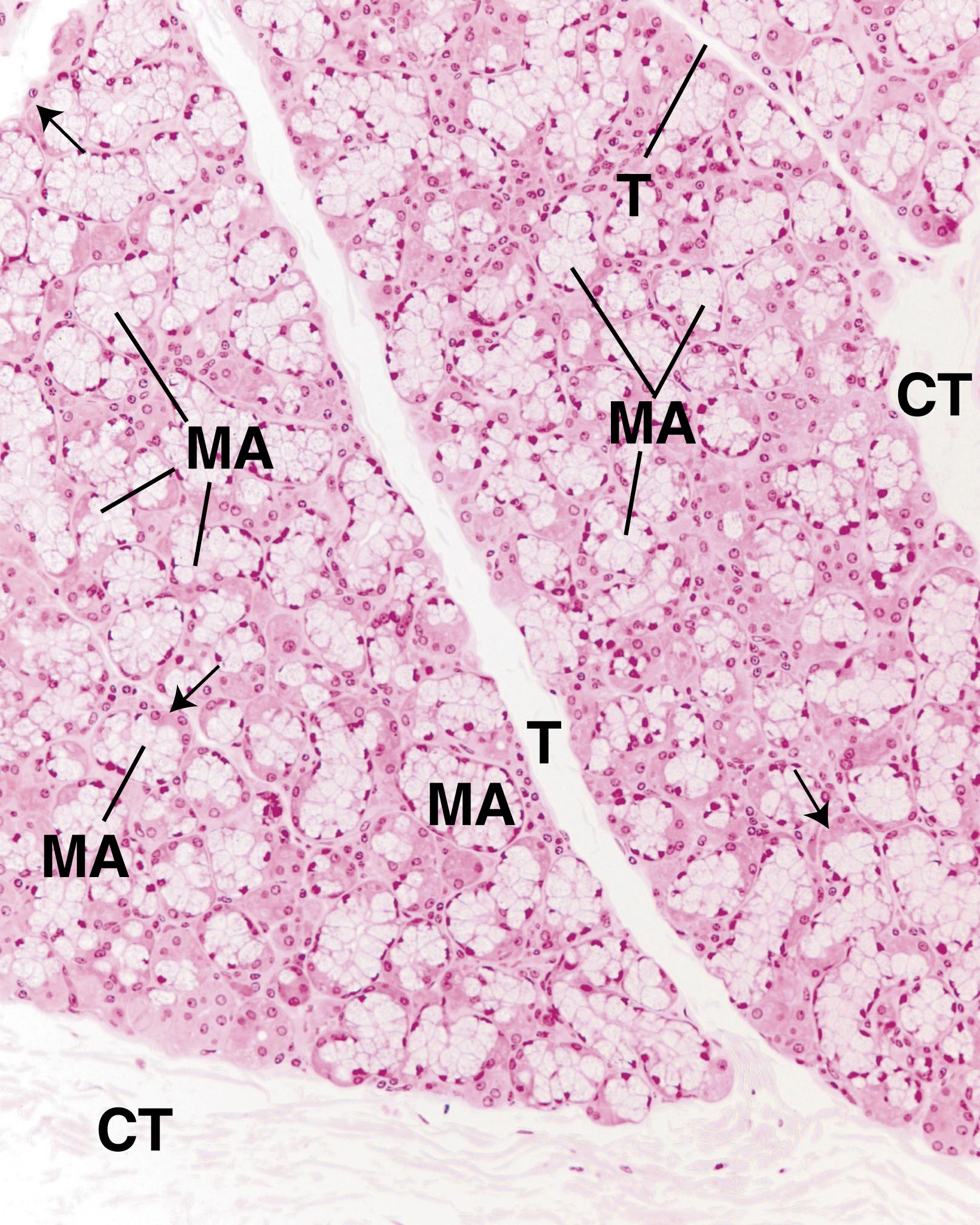
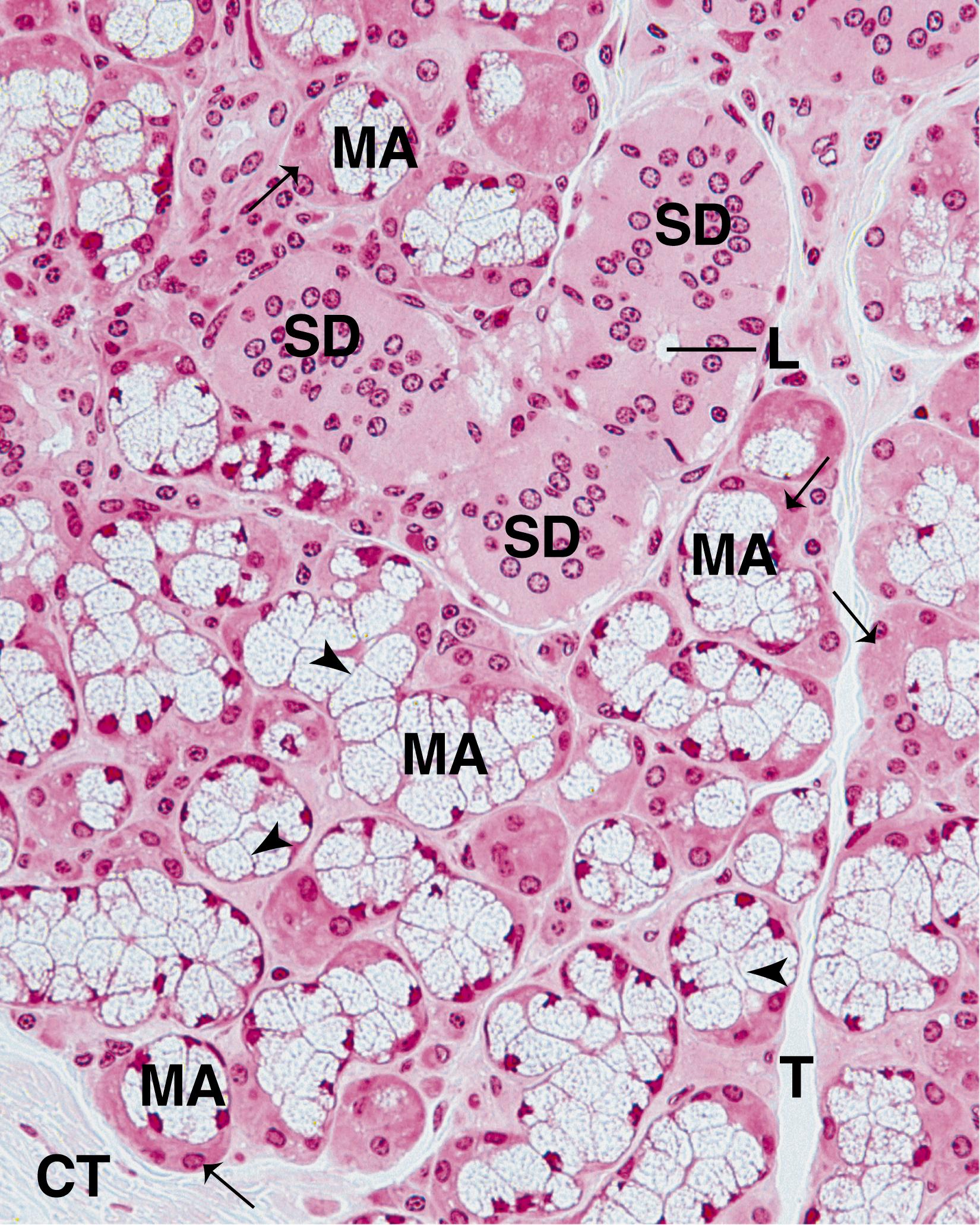
The sublingual gland has a slender connective tissue capsule, and its duct system does not form a terminal duct. Instead, several ducts open into the floor of the mouth and into the duct of the submandibular gland. Because of the organization of the ducts, some authors consider the sublingual gland to be composed of several smaller glandular subunits.
The paired submandibular glands produce 60% of the total salivary output. Although these glands manufacture a mixed saliva, the saliva that they produce is mostly serous.
The pair of submandibular glands , although only 12 to 15 g in weight each, produces approximately 60% of the total salivary output. About 90% of the acini produce serous saliva, whereas the remainder of the acini manufactures a mucous saliva. Electron micrographs of the apical aspects of the serous cells display electron-dense secretory products, with a denser core, within membrane-bound secretory granules. The number of serous demilunes is limited. The striated ducts of the submandibular gland are much longer than those of the parotid or sublingual glands; therefore, histological sections of this gland display many cross-sectional profiles of these ducts, a characteristic feature of the submandibular gland ( Figs. 18.8–18.10 ).
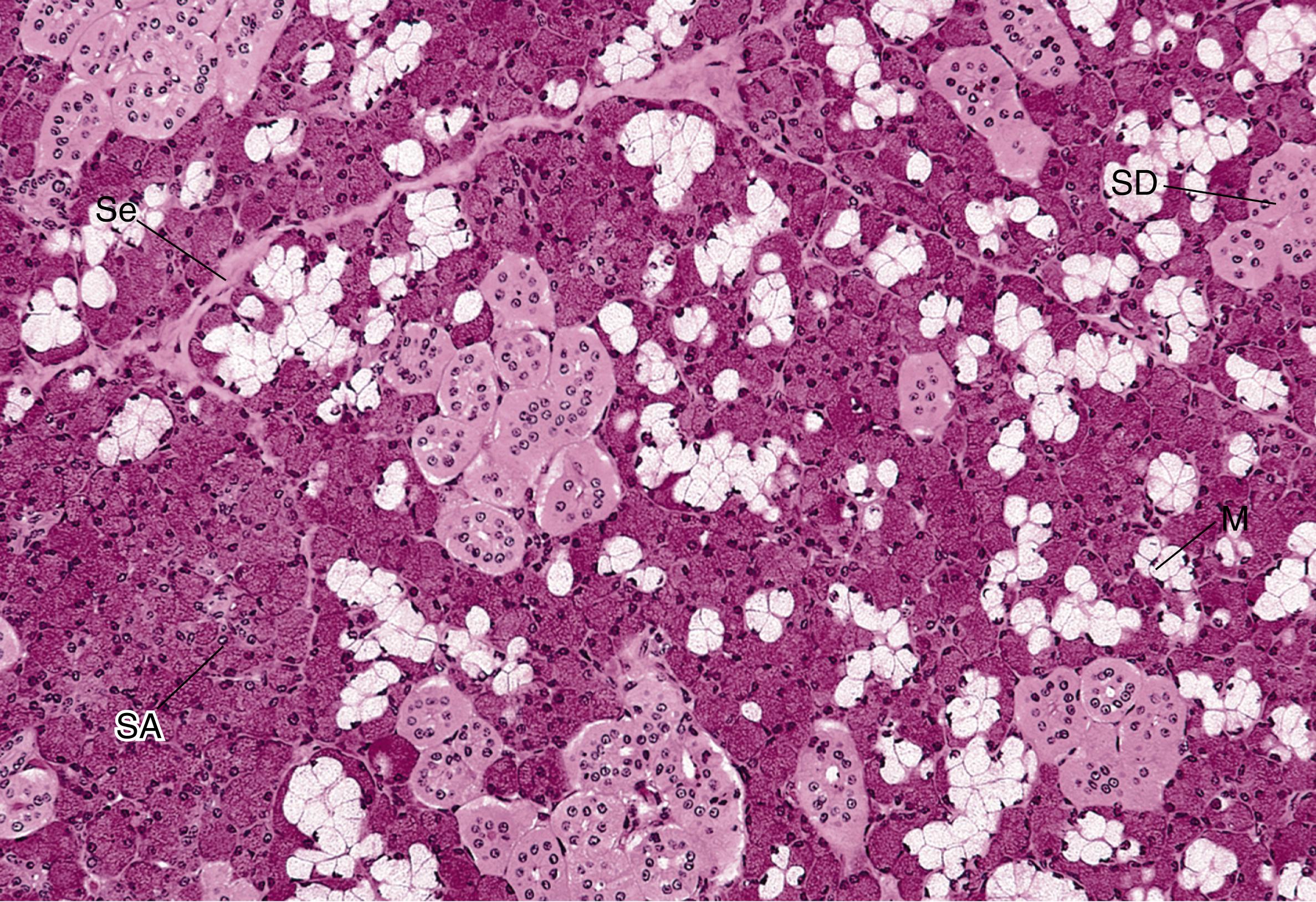
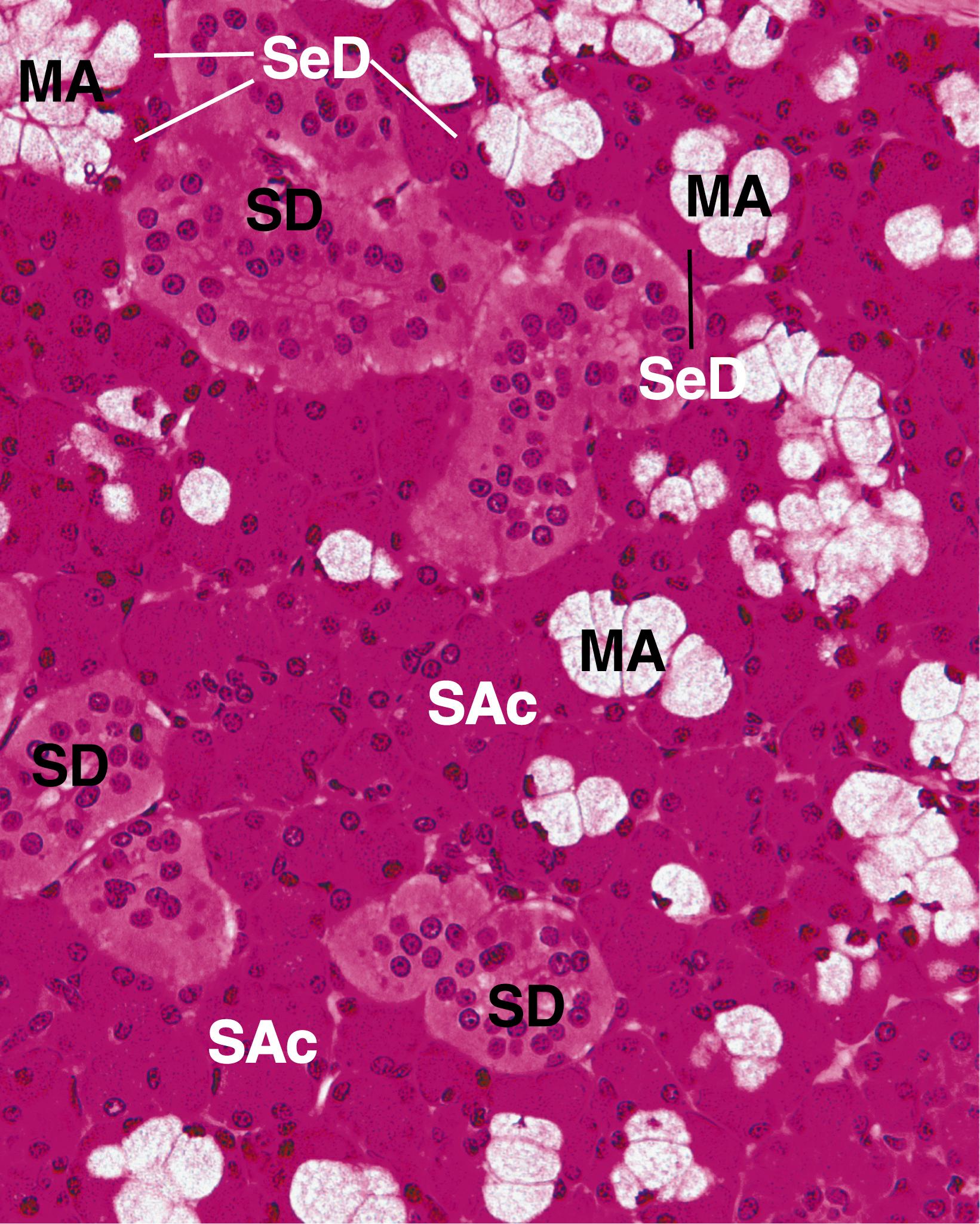
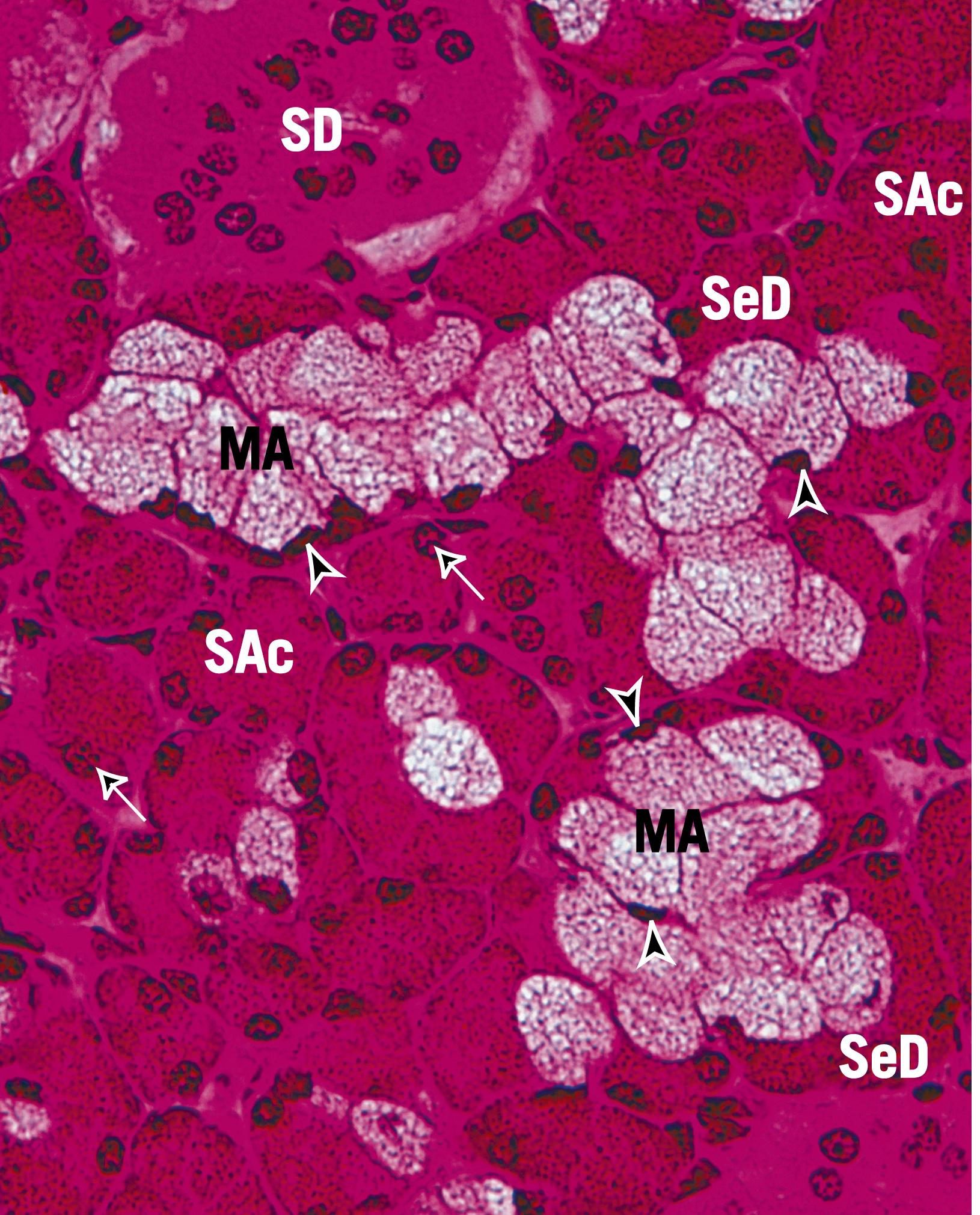
The connective tissue capsule of the submandibular gland is extensive and forms abundant septa, which subdivide the gland into lobes and lobules. Fatty infiltration of the connective tissue elements into the parenchyma is evident by midlife.
Benign pleomorphic adenoma , a noncancerous salivary gland tumor, usually affects the parotid and submandibular glands. Surgical removal of the parotid gland must be performed with care because of the presence of the facial nerve plexus within the substance of the gland. Because the facial nerve supplies motor innervation to the muscles of facial expression, damage to its branches during parotidectomy may cause temporary or even permanent paralysis of the muscles served by the damaged fibers.
The parotid gland (and occasionally other major salivary glands) is also affected by viral infections, causing mumps , a painful disease in children that may result in sterility when it affects adults.
About 25% of the cancers involving the parotid gland are considered to be acinic cell carcinoma , a slow-growing malignancy that can recur after surgical removal. Occasionally, the carcinoma metastasizes to other organs.
The pancreas is both an exocrine gland that produces digestive juices and an endocrine gland that manufactures hormones.
The pancreas , about 25 cm long, 5 cm wide, and 1 to 2 cm thick, weighing approximately 150 g, is situated on the posterior body wall, deep to the peritoneum. It has four regions: uncinate process, head, body, and tail. Its flimsy connective tissue capsule forms septa, which subdivide the gland into lobules and conveys its vascular and nerve supply, as well as its system of ducts. The pancreas produces exocrine and endocrine secretions. Scattered among its exocrine secretory acini are the endocrine components of the pancreas, known as islets of Langerhans ( Figs. 18.11 and 18.12 ).

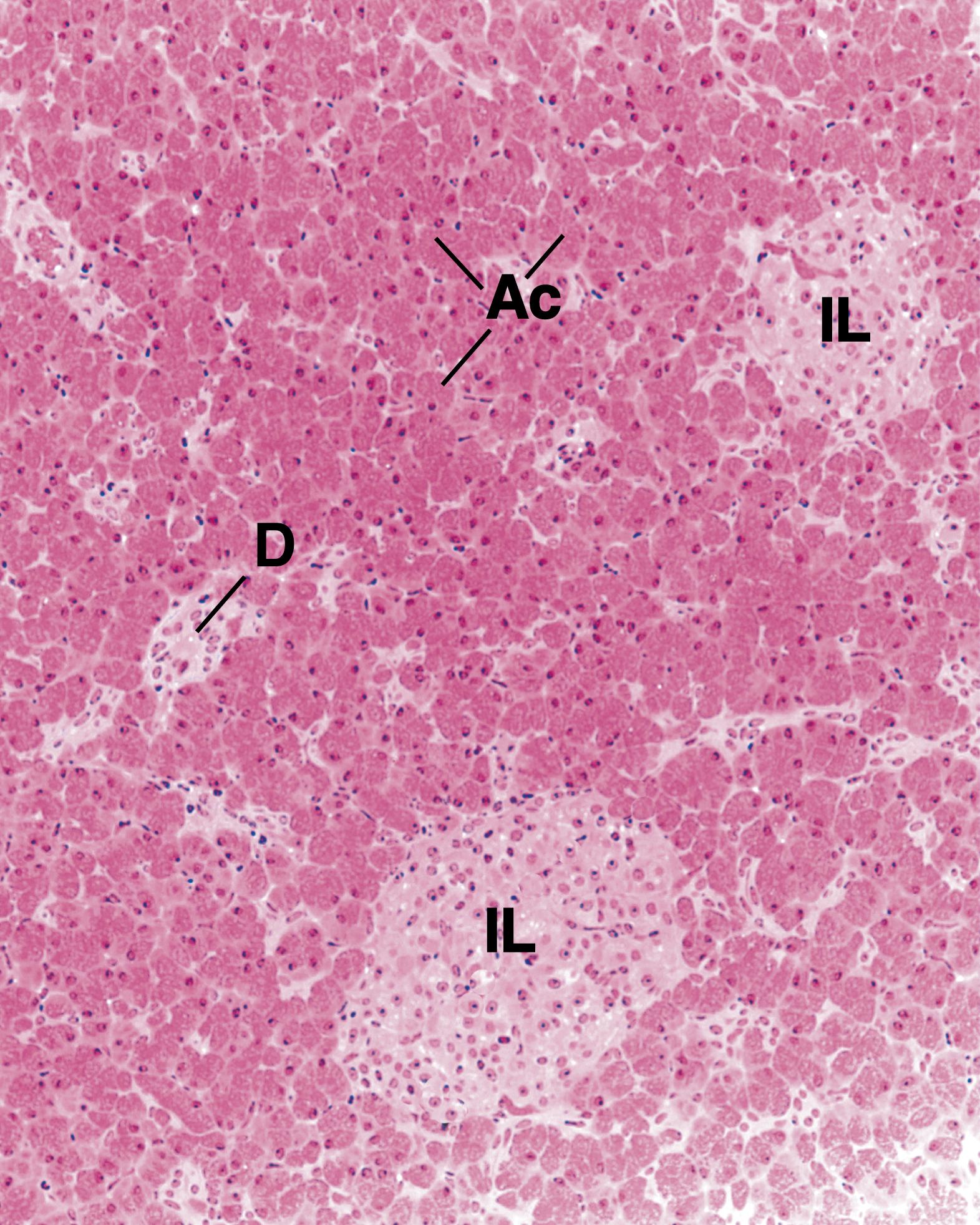
The exocrine pancreas is a compound tubuloacinar gland that produces daily about 1200 mL of a bicarbonate-rich fluid containing digestive proenzymes. Forty to 50 acinar cells form a round to oval acinus whose lumen is occupied by three or four centroacinar cells , the beginning of the duct system of the pancreas. The presence of centroacinar cells in the center of the acinus is a distinguishing characteristic of the exocrine portion of this gland.
The acinar cells of the pancreas have receptors for the hormone cholecystokinin (CCK) and the neurotransmitter acetylcholine , whereas the centroacinar cells and intercalated ducts have receptors for secretin and for acetylcholine.
Each acinar cell is shaped like a truncated pyramid, with its base positioned on the basal lamina separating the acinar cells from the connective tissue compartment. The round nucleus of the cell is basally located and surrounded by basophilic cytoplasm. The apex of the cell, facing the lumen of the acinus, is filled with proenzyme-containing secretory granules ( zymogen granules ), whose number diminishes after a meal ( Fig. 18.13 and 18.14 ).
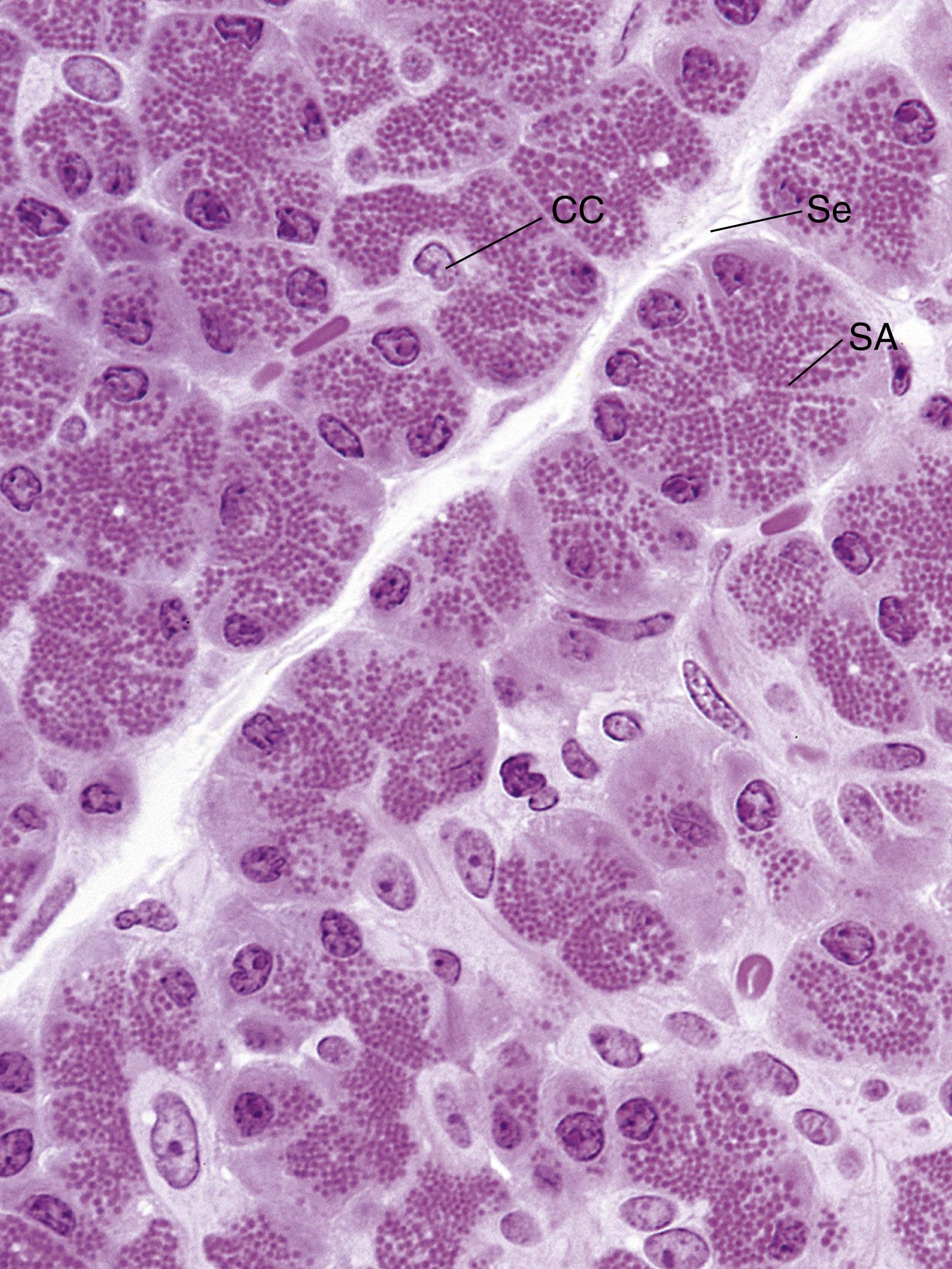
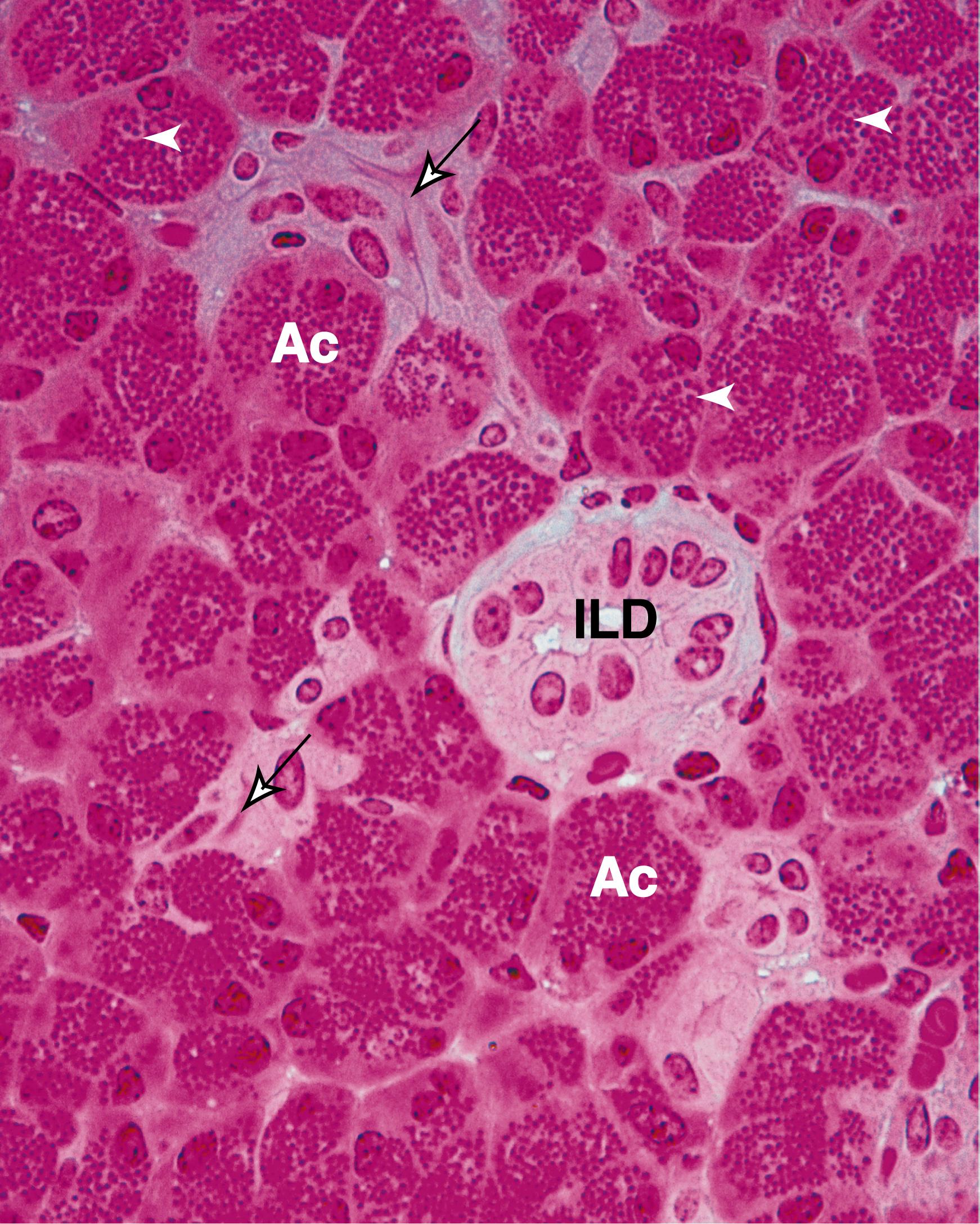
Electron micrographs of acinar cells display an abundance of basally located RER, a rich supply of polysomes, and numerous mitochondria exhibiting matrix granules. The Golgi apparatus is well developed but fluctuates in size, being smaller when the zymogen granules are numerous and larger after the granules release their contents. The zymogen granules may release their contents individually, or several secretory vesicles may fuse, forming a channel to the lumen of the acinus from the apical cytoplasm.
The basal cell membranes of acinar cells have receptors for the hormone CCK , released by diffuse neuroendocrine system (DNES) cells of the small intestine, and for the neurotransmitter acetylcholine , released by postganglionic parasympathetic nerve fibers.
The duct system of the pancreas begins within the center of the acinus with the terminus of the intercalated ducts , composed of pale, low cuboidal centroacinar cells (see Figs. 18.11 and 18.13 ). Centroacinar cells and intercalated ducts both have receptors on their basal plasmalemma for the hormone secretin , released by DNES cells of the small intestine, and acetylcholine , released by postganglionic parasympathetic fibers. Intercalated ducts join to form larger intralobular ducts , several of which converge to form interlobular ducts . These ducts are surrounded by a considerable amount of connective tissue and deliver their contents into the main pancreatic duct , which joins the common bile duct before opening in the duodenum at the papilla of Vater .
The acinar cells manufacture and release digestive enzymes, whereas the centroacinar cells and intercalated duct cells release a bicarbonate-rich buffer solution.
The acinar cells of the exocrine pancreas manufacture, store, and release a large number of enzymes: pancreatic amylase; pancreatic lipase; pancreatic cholesterol esterase; ribonuclease (RNase); deoxyribonuclease (DNase); elastase; and the proenzymes trypsinogen, chymotrypsinogen, and procarboxypolypeptidase ( Table 18.1 ). The cells also manufacture trypsin inhibitor , a protein that protects the cell from accidental intracellular activation of trypsin, as well as its activation in the pancreatic duct.
| Enzyme/Proenzyme | Function |
|---|---|
| Enzymes | |
| Pancreatic amylase | Breaks down starches, carbohydrates (although it cannot hydrolyze cellulose or chitin), and glycogen into disaccharides |
| Pancreatic lipase | Breaks down fats into fatty acids and monoglycerides |
| Pancreatic cholesterol esterase | Breaks down cholesterol esters into cholesterol and fatty acids |
| DNase and RNase | Break down DNA and RNA, respectively |
| Elastase | Breaks down the major component of elastic fibers, namely, elastin |
| Proenzymes | |
| Trypsinogen | Converted into trypsin: breaks down proteins into short peptides |
| Chymotrypsinogen | Converted into chymotrypsin: breaks down proteins into short peptides |
| Procarboxypolypeptidase | Converted into carboxypolypeptidase: breaks down small peptides to form dipeptides and amino acids |
Release of the pancreatic enzymes is effected by the hormone CCK manufactured by DNES cells of the small intestine (especially of the duodenum), as well as by acetylcholine released by the postganglionic parasympathetic nerve fibers. Both CCK and acetylcholine have to bind to their respective receptors located in the basal plasmalemmae of the pancreatic acinar cells before the enzymes and proenzymes can be released from the acinar cells.
The centroacinar cells and intercalated ducts manufacture a serous, bicarbonate-rich alkaline fluid, which neutralizes and buffers the acid chyme that enters the duodenum from the pyloric stomach. This fluid is enzyme poor, and its release is effected by the hormone secretin , produced by enteroendocrine cells of the small intestine in conjunction with acetylcholine , released by the postganglionic parasympathetic nerve fibers. Both secretin and acetylcholine have to bind to their respective receptors located in the basal plasmalemmae of the duct cells before the bicarbonate-rich fluid can be released from the duct cells. Thus, the enzyme-rich and enzyme-poor secretions are regulated separately, and the two secretions may be released at different times or concomitantly.
The mechanism of sodium bicarbonate secretion is facilitated by the enzyme carbonic anhydrase , which catalyzes the formation of carbonic acid (H 2 CO 3 ) from water (H 2 O) and carbon dioxide (CO 2 ). In the aquatic medium of the cytosol, H 2 CO 3 dissociates to form H + and HCO 3 – ; the HCO 3 − is actively transported into the lumen of the duct, and the hydrogen (H + ) ion is actively transported into the connective tissue elements in exchange for sodium ions (Na + ). The Na + passively enters the lumen, where it joins the HCO 3 − to form sodium bicarbonate. The movement of sodium and bicarbonate ions from the cell into the lumen of the duct establishes an osmotic gradient that is followed ( passively ) by the movement of water from the connective tissue into the duct cell and then into the lumen of the duct. This results in the creation of a buffer solution of sodium bicarbonate that is conveyed by the pancreatic duct into the duodenum to buffer the highly acidic chyme that enters the duodenum from the pyloric stomach.
Occasionally, the pancreatic digestive enzymes become active within the cytoplasm of the acinar cells, resulting in acute pancreatitis , which is often fatal. The histological changes involve inflammatory reaction, necrosis of the blood vessels, proteolysis of the pancreatic parenchyma, and enzymatic destruction of adipose cells, not only within the pancreas but also in the surrounding region of the abdominal cavity.
Pancreatic cancer is the fifth leading cause of mortality from all cancers, killing about 25,000 people in the United States per year. Fewer than 50% of patients survive more than 1 year, and fewer than 5% survive 5 years. Men are more susceptible to this disease than women. Cigarette smokers have a 70% greater risk for development of pancreatic cancers than nonsmokers.
The endocrine pancreas is composed of spherical aggregates of cells, known as islets of Langerhans, that are scattered among the acini.
Each islet of Langerhans is a richly vascularized spherical conglomeration of approximately 3000 cells. The approximately 1 to 2 million islets distributed throughout the human pancreas constitute the endocrine pancreas. A somewhat greater number of islets are present in the tail than in the remaining regions. Each islet is about 300 μm in diameter and is surrounded by reticular fibers, which also enter the substance of the islet to encircle the network of capillaries that pervade it ( Figs. 18.12 and 18.15 ).
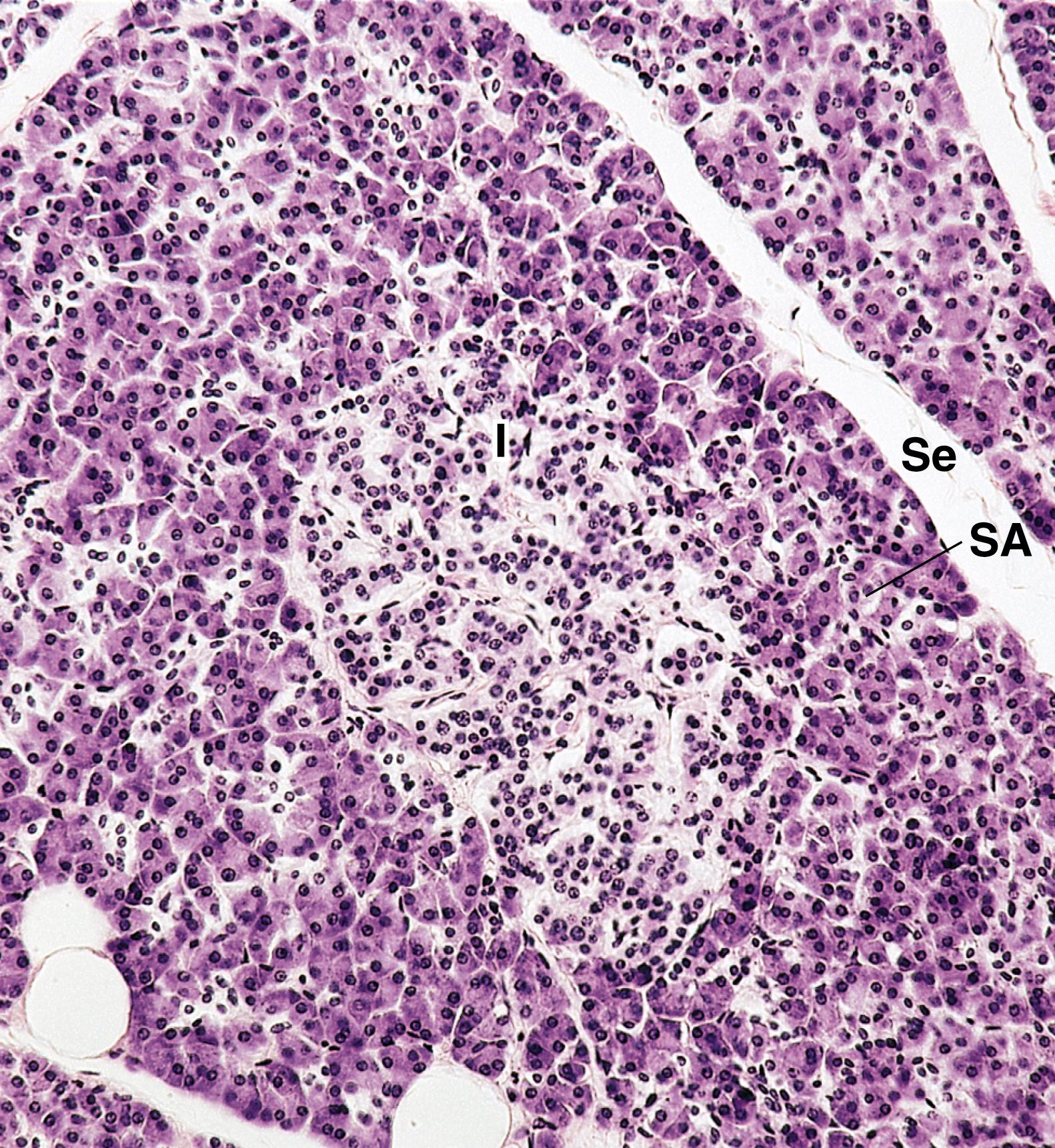
Become a Clinical Tree membership for Full access and enjoy Unlimited articles
If you are a member. Log in here